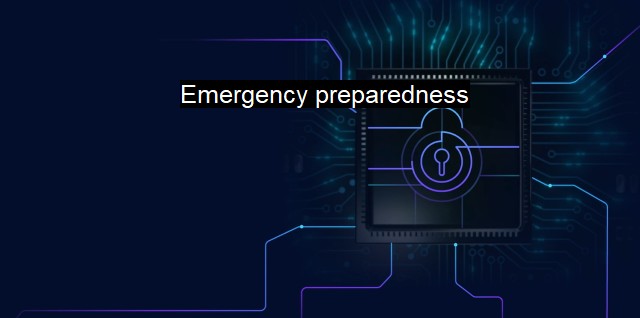What are Emergency preparedness?
Strengthening Emergency Preparedness in the Digital Age: The Critical Role of Cybersecurity Measures and Antivirus Practices
Emergency preparedness is an essential element of planning and effective security protocols for any organization. In our ever-increasing digital age, the importance of emergency preparedness in the context of cybersecurity cannot be overstated. This involves establishing and implementing plans to protect the organization's computer systems, networks, and data from potential threats or disruptions.The most effective form of emergency preparedness in cybersecurity is in answering the "if" and not the "when" questions. Adverse incidents, such as cyberattacks, are unpredictable, but the likelihood today is increasingly high. Therefore, the approach of responding to cyber threats is not only a requirement for business continuity but has now become a necessary condition to prevent data privacy violations and subsequent financial and reputational losses.
Cybersecurity emergency preparedness encompasses several steps such as identification, protection, detection, response, and restoration. Identification involves proactive actions that identify valuable digital assets, such as data and applications, and what potential threats they might be exposed to. Protection, on the other hand, is about shielding these digital assets through a multitude of precautions-text such as firewalls, encryption, and antiviruses to deter unauthorised invasion or access.
The role of antiviruses in emergency preparedness rides on their ability to detect and neutralize threats. Antivirus software is built to observe patterns in the system that may indicate the presence of malicious software or anomalies in the operation of computers. Its detection power feeds into the response stage of emergency preparedness, allowing the swift isolation of infected elements without causing extensive damage.
The architecture of cyber emergency preparedness also includes identifing potential vulnerabilities, prioritising these according to their level of risk, and then implementing the steps required to mitigate or prevent these risks. This is where software and system updates play an anchoring role. They patch up vulnerabilities in systems, ensuring software runs the latest secure version. Other hardware or software tools, such as artificial intelligence and machine learning, can aid in identifying anomalies and informing the response deployed.
Well-defined and clear communication plans are vital in cybersecurity emergency preparedness. Efficient reporting structures, communication lines, and authority figures assigned to lead or coordinate during incidents prove invaluable to ensuring rapid palliative and corrective actions. Employee education is another critical aspect as it reduces an organization's vulnerability to insider risks and helps employees understand what to do in case of a cyber incident.
Post-incident, emergency plans should include experiences learned from previous incidents within and outside the organization. These Periodic assessments and revisions accommodate changes in personnel, technology, and emerging threats while ownership and responsibility of the emergency plan also takes centerstage in effective cybersecurity preparednes.
Emergency preparedness is the protective umbrella that shields IT systems and data. By encompassing preventive measures, detection and response tactics, and recovery strategies, it serves as the frontline defense against cybersecurity threats. With interwoven elements like antiviruses, firewalls, software updates, and well-defined communication lines, a sound emergency preparedness plan combines technology and individuals' vigilance to foster a secure digital culture.

Emergency preparedness FAQs
What is emergency preparedness in the context of cybersecurity and antivirus?
Emergency preparedness in the context of cybersecurity and antivirus entails developing plans and procedures to ensure that your systems are protected and your data is safe in the event of a cyber attack or virus outbreak. This includes having backup systems in place, ensuring that all software and security systems are up to date, and having protocols in place to handle a breach or other emergency situation.How can I prepare my organization for a cybersecurity emergency?
To prepare your organization for a cybersecurity emergency, you need to develop a comprehensive plan that includes identifying potential threats, establishing roles and responsibilities, implementing security measures, and conducting regular training and testing. It is also important to have a communication plan in place to ensure that everyone is aware of what is happening and what steps they need to take.What should I do if I suspect a cyber attack or virus on my system?
If you suspect a cyber attack or virus on your system, it is important to act quickly. You should immediately disconnect your computer or device from the internet and any networks to prevent the malware from spreading. You should then contact your IT department or a cybersecurity professional to help you diagnose and resolve the problem.How can I stay up to date on the latest cybersecurity threats and vulnerabilities?
Staying up to date on the latest cybersecurity threats and vulnerabilities is crucial for effective emergency preparedness. You can do this by regularly reading industry publications and news sources, attending training or educational events, and following experts in the field on social media. You should also work with your IT department or a cybersecurity professional to conduct regular vulnerability assessments and identify areas where you may be at risk.| | A | | | B | | | C | | | D | | | E | | | F | | | G | | | H | | | I | | | J | | | K | | | L | | | M | |
| | N | | | O | | | P | | | Q | | | R | | | S | | | T | | | U | | | V | | | W | | | X | | | Y | | | Z | |
| | 1 | | | 2 | | | 3 | | | 4 | | | 7 | | | 8 | | |||||||